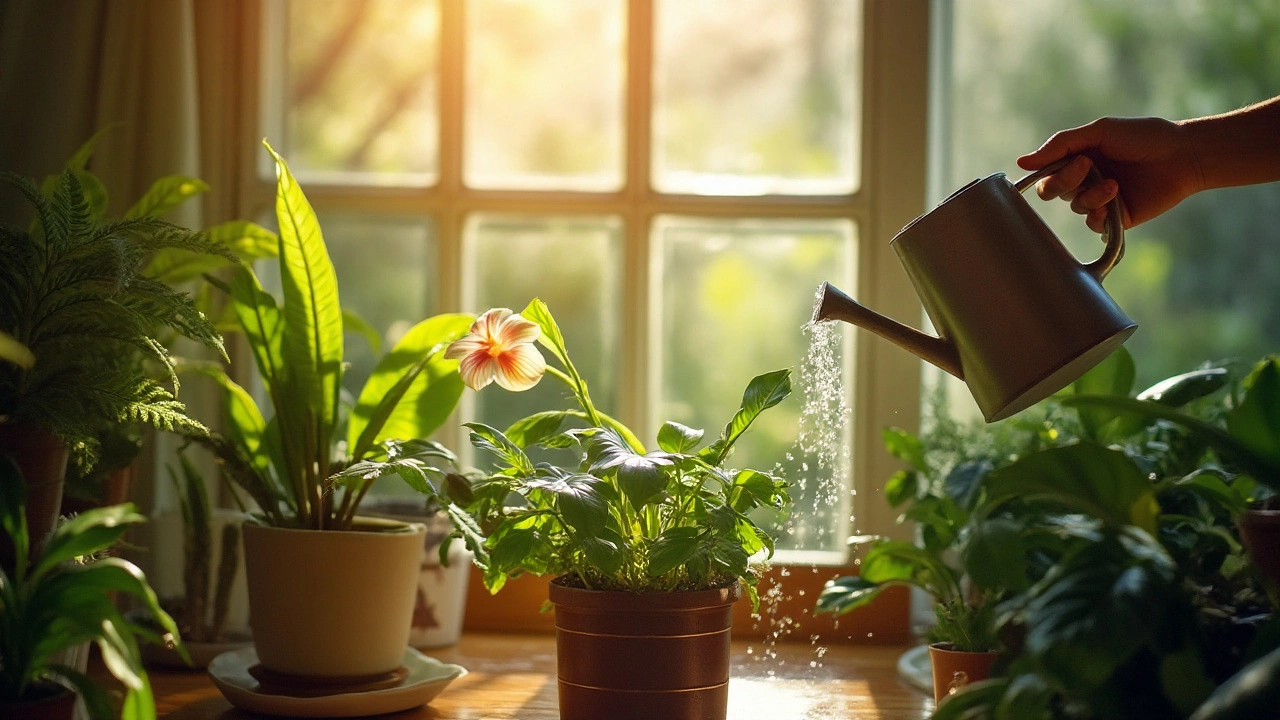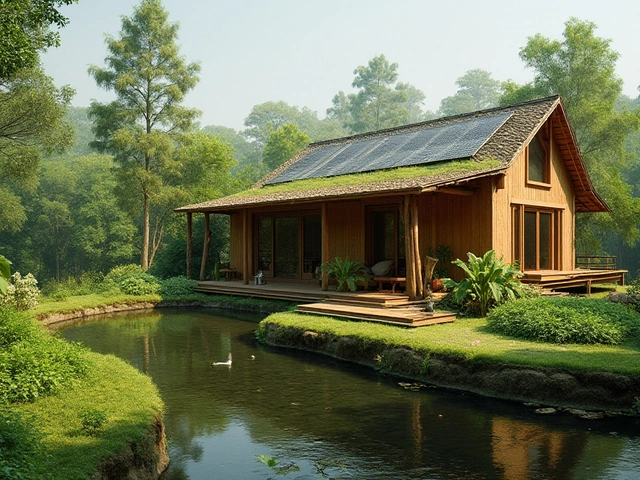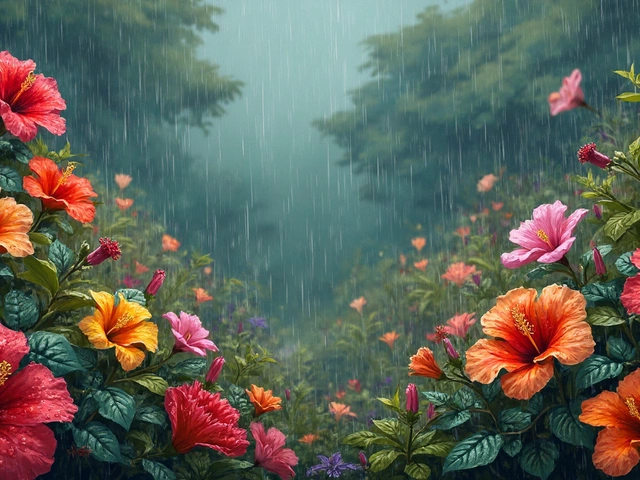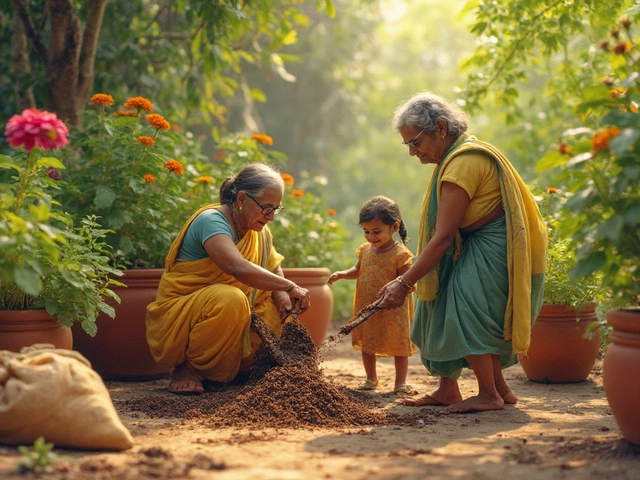Watering your indoor plants is more than just a routine task; it's a crucial part of keeping your green friends healthy and vibrant. One key question that often pops up is whether the timing of watering—day or night—makes a difference. The answer isn't one-size-fits-all; various factors play a role in determining the best watering time.
Understanding your plant's needs and environment can guide you in making the right choice. Both day and night watering have their own set of benefits and challenges. As we explore these options, you’ll gain insights into how timing affects water absorption, plant health, and overall growth. Whether you're a seasoned plant parent or new to the world of indoor gardening, these tips can help you create the ideal care routine for your leafy companions.
- Understanding Plant Water Needs
- Daytime Watering: Pros and Cons
- Nighttime Watering: Benefits and Drawbacks
- Tips for Effective Watering
- Adapting to Specific Plant Varieties
Understanding Plant Water Needs
Plant hydration is one of the cornerstones of successful indoor gardening, and the water needs of your plant can vary widely depending on a number of factors. The type of plant, its size, the season, and even the humidity levels in your home all play a role. A cactus in a sunlit room, for example, will have dramatically different needs compared to a fern in a shady corner. As a rule of thumb, most indoor plants should be watered when the top inch of soil feels dry to the touch, but it's essential to dig deeper and figure out what works best for each plant.
Watering your plants seems straightforward, but it's about understanding their specific thirst. For instance, tropical plants often require consistently moist soil, but not to the point of waterlogging. Waterlogged roots can suffer from a lack of oxygen, leading to root rot, which is unfortunately a common ailment among indoor plants. On the other hand, succulents and cacti are adapted to arid conditions and prefer the soil to dry out completely between waterings. This simple distinction can make an enormous difference in the health and vibrancy of your plants. As gardener extraordinaire David Hobson once said,
"I grow plants for many reasons: to please my eye or to please my soul, to challenge the elements or to challenge my patience, for novelty or for nostalgia, but mostly for the joy in seeing them grow."So, knowing what pleases your plant’s ‘soul’ is crucial.
Understanding how environmental factors influence water needs is equally important. House temperatures, light exposure, and humidity can all change how much water a plant requires. In the winter, for instance, plants may need less water because they are in a dormant period. But if they are sitting on a windowsill above a radiator, they might need more frequent watering. High temperatures and bright lights can cause water to evaporate faster, meaning your plant is thirstier than usual. It's a balancing act not unlike parenting, as you adjust conditions to see what gets the best out of them.
Another tip for understanding water needs is observing your plants closely. Drooping leaves can be a sign of both underwatering and overwatering, so it’s important to take a closer look. Check the soil: if it's too dry or too soggy, you’ll need to adjust your watering schedule accordingly. Remember, plants are your visual guides; their appearance is often the best indicator of what they need from you.
Different plants require different approaches, and if you've got a jungle of variety, a little planning can go a long way. Create a watering schedule and keep notes on what works best for each individual plant. If you're new to indoor plant care, start with easy-to-manage species like pothos or snake plants, which can withstand a little neglect. As you become more attuned to the ecosystem of your home, you'll find that understanding your plant water needs transforms into a rewarding interplay between you and your greenery. Harnessing this knowledge will ensure that you’re not just watering plants, but sustaining life and fostering growth.
Daytime Watering: Pros and Cons
Watering indoor plants during the day is a common practice for many plant enthusiasts. There are several advantages to this approach that can benefit both the plants and their caretakers. During daylight hours, plants undergo photosynthesis, a process that requires water. Providing them with moisture when the sun is up supports this critical activity, helping plants to better manage their water needs and display healthier growth patterns. The warmth of the day assists in quick drying of any excess water on the foliage, which reduces the risk of fungal infections that thrive in moist, dark environments.
Daytime watering also complements the human schedule. It allows plant caretakers to monitor their plants in natural light, easily spotting any changes in soil moisture or plant health. This is especially beneficial for people with indoor plants in different rooms, as it provides a consistent routine across the board. Daylight watering can prevent water stagnation and accumulation by giving the soil sufficient time to dry out, an important factor in preventing root rot—a common ailment in houseplants.
However, there are downsides to daytime watering that should not be overlooked. High temperatures can lead to rapid evaporation, which means some plants might not receive adequate hydration if not watered thoroughly. This evaporation can also create misleading signs on the soil surface, making it appear drier than it actually is beneath. Additionally, depending on the plant species and sunlight exposure, there is a risk of sunburn on foliage if water droplets are left on leaves. These droplets act like mini magnifying glasses, focusing sun rays onto small patches of leaves and potentially causing damage.
Dr. Alice Stevens, a prominent botanist, shares in her book on plant care,
"The choice between day and night watering is nuanced. Consider the plant's natural habitat—tropical species may benefit from daytime watering, mimicking their rainforest origins, where rain is followed by sunlight."This insight shows the importance of understanding the specific requirements and natural environment of your plants. Moreover, some recent studies have shown that over 60% of indoor plant owners prefer daytime watering simply because it aligns with their daily routines and provides opportunities for routine plant inspections.
As a general guideline, mindful watering in the morning can help prepare your indoor plants for the day's environmental changes. If you're seeking to create a vibrant indoor garden, assess both the specific plant requirements and the environmental conditions within your home. Remember, the optimal watering time may vary from one plant to another, requiring you to adjust your practices accordingly. Adapting to these needs will ensure your green companions stay as lush and lively as possible.
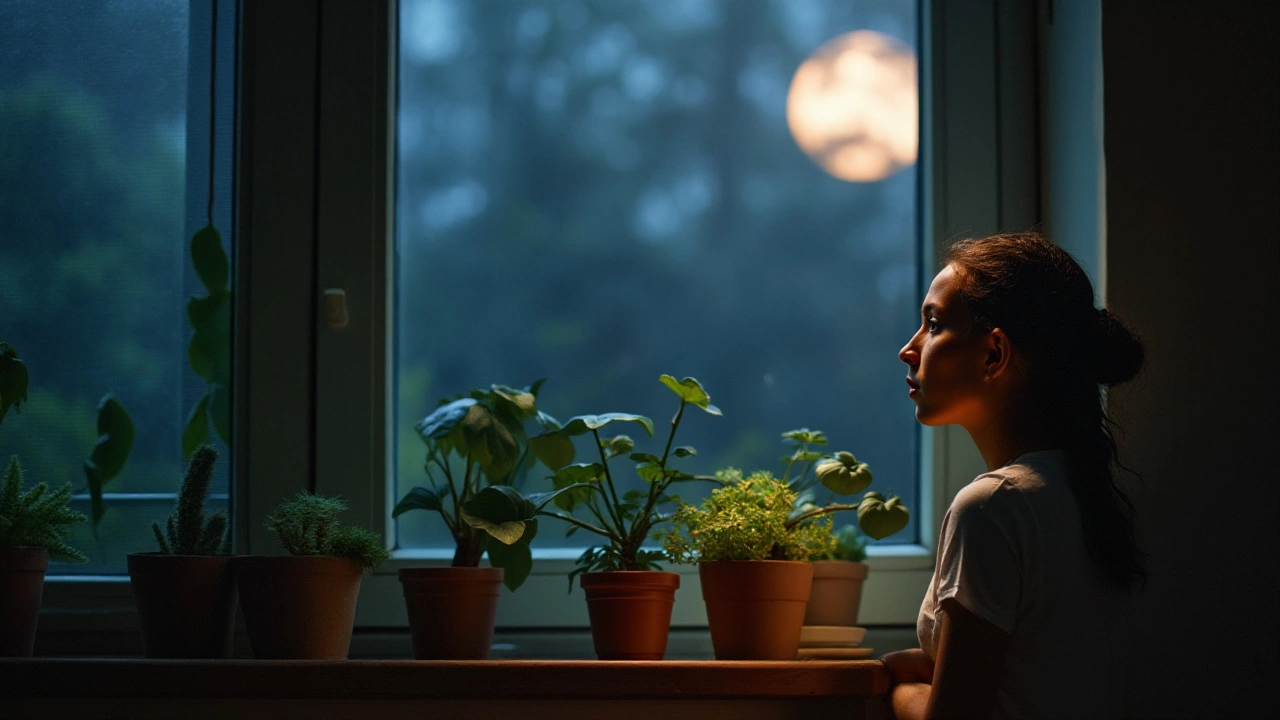
Nighttime Watering: Benefits and Drawbacks
Choosing the right time to water your indoor plants can be as crucial as selecting the plants themselves. Some gardeners favor nighttime watering for its potential benefits. One of the main advantages is the cooler temperatures at night, which can reduce evaporation rates significantly. This means more water is available for the plants to absorb, and less is lost to the air. For plant care enthusiasts, this might seem ideal, especially in warmer climates where daytime temperatures can lead to rapid evaporation.
However, nighttime watering isn’t without its drawbacks. Water left on the leaves overnight can encourage fungal growth or attract pests, both of which can damage your plants. If the soil remains too moist during nighttime hours, it may also contribute to root rot, a common problem among houseplants. It's vital to ensure that excess water can drain away effectively to prevent these issues from arising. As Michael Pollan once noted, "The garden suggests there might be a place where we can meet nature halfway." This balance is crucial when dealing with watering schedules.
Another critical aspect to consider about nighttime watering is plant respiration rates. After sunset, plants have a slower metabolism, which can affect how they take up water. While they might be less efficient in water uptake, the stable conditions at night allow for consistent moisture levels, especially if you’ve ensured good soil drainage. However, if water uptake is sluggish, this stagnant moisture can again put your plants at risk.
Data collected from various gardening studies highlights an interesting trend: indoor plants watered at night sometimes exhibit longer recovery times from water stress. This benefit might outweigh the risk of fungal infections for those dealing with plants that are particularly sensitive to dry conditions.
In summary, nighttime watering can be beneficial for specific conditions and plant types, reducing evaporation losses and sometimes helping stressed plants return to health. Yet, it also brings risks like fungal growth and waterlogging, which must be managed thoughtfully. Understanding the unique needs of your plant species can help in choosing the best approach. For passionate plant caregivers, the time of watering can indeed influence the growth and well-being of your indoor oasis.
Tips for Effective Watering
Ensuring the vitality of your indoor plants involves not only knowing when to water but also mastering how to water. One fundamental aspect of effective watering is understanding the unique hydration needs of each indoor plant. Different plants have varying water requirements; succulents like cacti prefer dry conditions with infrequent but deep watering sessions, whereas tropical plants such as ferns thrive with consistent moisture. Recognizing these distinctions is the first step toward effective plant care. When watering, aim for the soil to be damp rather than soaking wet, as overwatering can lead to root rot, a common plant ailment. It's beneficial to allow the top inch of soil to dry out between waterings for most species, except those that require consistently moist environments.
Another consideration is the type of water you use for your plants. Tap water might contain minerals and chemicals like chlorine and fluoride, which can accumulate in soil over time and harm sensitive plants. If your local tap water quality is in question, it's wise to use filtered or rainwater. Temperature matters, too; using room temperature water is ideal since water that's too cold or too hot can shock plant roots. By maintaining a consistent watering routine, plants can better establish their growth patterns. Establishing a watering schedule ensures a plant doesn't go too long without moisture and prevents the temptation of waterlogging during a dry spell.
According to the Royal Horticultural Society, "Watering at the base of the plant, rather than over the foliage, helps to direct water right to the roots, reducing the risk of foliar diseases."
Monitoring the humidity level in your home is another important factor in watering indoor plants. Many houseplants are native to humid environments and may need additional water or a boost in humidity, especially during dry winters. Consider investing in a simple hygrometer to track ambient humidity levels. For plants that are prone to humidity changes, such as orchids, try grouping plants together to create a microclimate or place a shallow dish of water nearby to evaporate, subtly increasing the moisture in the air. Using mulch or pebbles on the surface of the soil can also help retain moisture and keep the roots cool.
Lastly, consider the container and its drainage properties. Pots with good drainage are essential to prevent water from building up at the bottom, which can result in root suffocation and rot. Ensure that the pot has drainage holes and use saucers to catch excess water. During the watering process, observe the drainage rate; water should flow through within a few minutes, indicating a healthy soil mix. If not, it might be time to reassess the soil composition, possibly incorporating perlite or sand to improve aeration and drainage. With these plant care tips, your household jungle will continue to thrive and grow lush and vibrant.
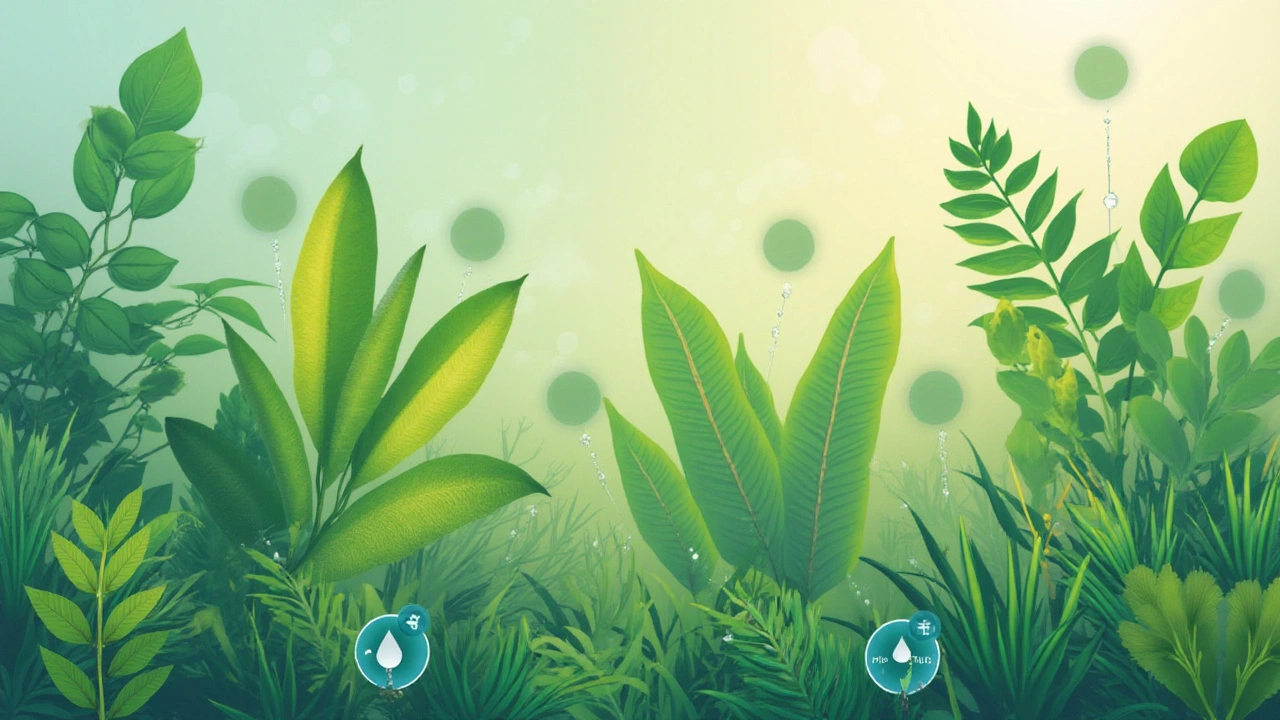
Adapting to Specific Plant Varieties
Indoor plants come in a dazzling array of shapes, sizes, and personalities, each demanding its own set of care instructions. Understanding how to cater to the individual needs of your indoor plants can mean the difference between a flourishing indoor garden and a droopy, yellowing accident. The watering requirements can vary dramatically even among plants that appear similar at first glance.
Take, for example, the succulents—a favorite choice for those looking for a low-maintenance, aesthetically pleasing addition to their homes. These hardy plants are native to arid regions and have adapted themselves to store water in their fleshy leaves. As such, succulents prefer minimal watering and are particularly susceptible to root rot if kept too wet. But here's the catch: they still appreciate a specific watering time. Morning is often recommended, as the heat of the day helps evaporate excess moisture, preventing an overly soggy environment.'
On the flip side, plants like ferns and orchids, which thrive in more humid conditions, may benefit from less direct sun exposure when watered. Early evening watering might fit their schedule better, allowing them to soak up the moisture without the harsh rays of midday sunlight evaporating it too quickly. This timing can help mimic their natural habitat, contributing to a happier and healthier plant.
Watering Tropical Plants
Tropical plants, such as the ever-popular monstera and the more exotic calathea, often hail from lush rainforests where they receive consistent moisture. For these plant varieties, consistency is crucial. Regular watering, spaced evenly throughout the week, can help balance their demand for humidity. It's interesting to note that while timing might not be as critical here, the application method might be. Using a mister in addition to traditional watering can replicate the humid conditions they adore. A 1985 study published in the 'Journal of Tropical Ecology' found that even distribution of moisture significantly increased leaf surface health in tropical plant species. This tidbit further affirms the importance of keeping our watering techniques as close to nature as possible.
"The secret to getting that lush, gardener-envy look from your tropical houseplants often lies not just in watering but in recreating an atmosphere that speaks to their roots," says renowned horticulturist Eliza Green in 'The Secrets of a Green Thumb'.
For those who like to push the boundaries with exotic plants like bonsai or carnivorous plants, the approach becomes even more unique. These plants can be particular about their watering needs—often preferring distilled or rainwater rather than tap water due to its mineral content. Timing might also depend on their natural cycles; for instance, carnivorous plants might require more in tune watering during active growing periods. Again, listening to the specific needs of each variety, and adjusting your strategy accordingly, can yield exceptional results.
